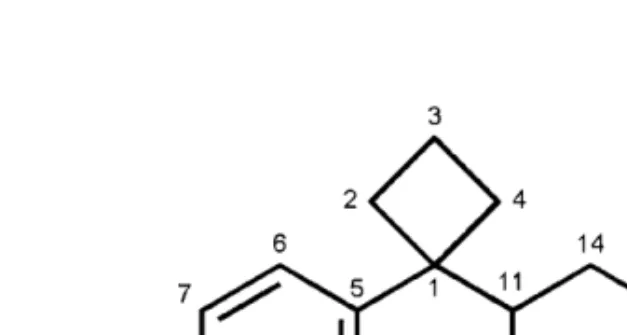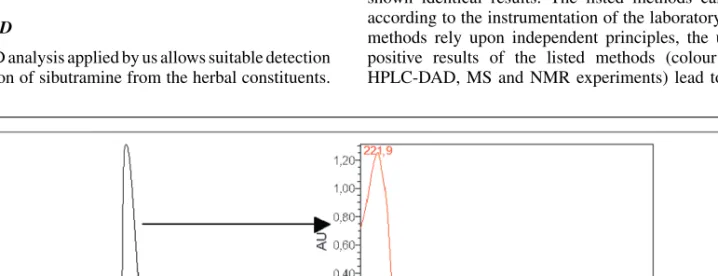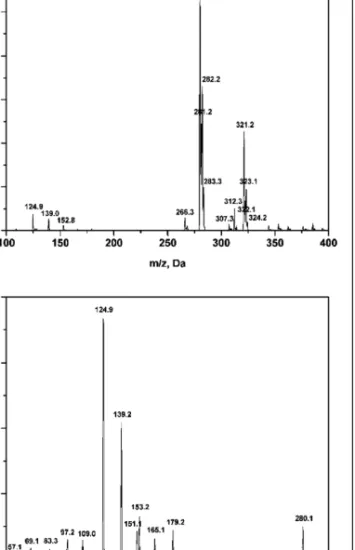ORIGINAL ARTICLES
Department of Pharmacognosy, University of Szeged, Szeged, Hungary
Rapid identification of sibutramine in dietary supplements using a stepwise approach
D. Csupor, K. Boros, B. Dankó, K. Veres, K. Szendrei, J. Hohmann
Received March 20, 2012, accepted June 29, 2012
Deszo Csupor, Department of Pharmacognosy, University of Szeged, H-6720 Szeged, Eötvös u. 6, Hungary csupor.dezso@pharmacognosy.hu
Pharmazie 68: 15–18 (2013) doi: 10.1691/ph.2013.2069
Adulteration of botanical food supplements with undeclared synthetic drugs is a common problem. One of the most affected product groups are the slimming agents. There are no analytical protocols for the detection of synthetic adulterants from these products. The present study aimed at the development of a multistep analytical method for the quick and reliable determination of sibutramine, one of the most common adulterants among botanical food supplements. The extract of a sibutramine-containing slimming formula was analysed by colour tests, TLC, HPLC-DAD, MS and NMR. The multistep method proposed by the authors allows the quick identification of sibutramine in counterfeit samples in laboratories with different instrumentation.
1. Introduction
In the developed countries there is an increasing demand for slimming medicines. One major group of compounds applied in the treatment of obesity act through the stimulation of the central nervous system, enhancement of metabolism and suppression of appetite. The ATC group A08AA “centrally acting antiobesity products” consists of several active agents (e.g. phentermine, fenfluramine, amfepramone, dexfenfluramine, mazindol, ethy- lamphetamine, cathine, clobenzorex, mefenorex, sibutramine) (WHO 2011), however, many of these molecules have been removed from the market because of their undesirable effects (Ioannides-Demos et al. 2011). Their side effect profiles are related to the chemical and pharmacological similarities of these compounds to amphetamine. The number of anorectic agents available in the European Union and USA has nar- rowed to very few compounds. The European Medicines Agency recommended the withdrawal of phentermine, fenfluramine, amfepramone and clobenzorex from the market because of their unacceptable safety profile under normal conditions of use and limited therapeutic efficacy (EMA 2009).
One of the most popular compounds, sibutramine (Fig. 1) has recently been withdrawn from the market of Western countries.
The compound was withdrawn voluntarily by the manufacturer from the U.S. market in 2010 because of clinical trial data indi- cating an increased risk of heart attacks and strokes. Based on the evaluation of the currently available scientific data, the EMA concluded that the benefits of sibutramine-containing medicines do not outweigh their risks, and therefore recommended that the marketing authorisations for sibutramine-containing medicines be suspended across the EU (EMA 2010).
Parallelly to their withdrawal from the legal market, some of the above mentioned anorexiants reappeared in illegally adulterated products. Generally, counterfeit anorectic prepa- rations are claimed to contain only herbal drugs or extracts, however, their efficacy is in fact based on the presence of marked amounts of synthetic compounds. Beside some func-
Fig. 1: Chemical structure of sibutramine
tional foods and traditional Chinese medicines, the majority of the counterfeit products are registered or unregistered dietary supplements. One of the most frequently applied compounds as adulterant is sibutramine. In 2009 one article reported that 35 positive samples were found out of a total of 105 botanical dietary supplements, and the most common adulterant was sibu- tramine in slimming agents (Chen et al. 2009). In some cases sibutramine was detected in Chinese herbal medicines after observing side effects characteristic of sibutramine (Jung et al.
2006).
There are several, sophisticated methods (including HPLC- DAD, HPLC-MS and NMR) described in the literature for the reliable determination of sibutramine in medicinal produtcs and biological samples. However, in developing countries, where the percentage of counterfeit products on the market is rather high, a major limiting factor of the quality analysis of these products is the lack of proper instrumentation. The aim of our study was the development of a rapid, multistep analytical proto- col for the detection of sibutramine in dietary supplements. For this purpose we carried out the extensive analysis of a coun- terfeit. Our experiments were actuated by multiple cases of development of side effects characteristic to sibutramine after the consumption of a food supplement (Super Slim capsules) in Hungary.
Pharmazie 68 (2013) 15
ORIGINAL ARTICLES
2. Investigations and results 2.1. Sample preparation
The purification of sibutramine using SPE allowed the quick separation of the compound in the fraction eluted from the col- umn with CHCl3. The fraction eluted with MeOH also contained sibutramine along with herbal constituents.
2.2. Presumptive colour tests
In Simon’s test which is generally used as a test for sec- ondary amines, sibutramine, as a tertiary amine, gave a purple coloured reaction. In Chen’s test, which is used to distinguish ephedrine and its derivatives from amphetamine and metham- phetamine, sibutramine did not react, similarly to amphetamine derivatives. Marquis test, which allows the distinction between amphetamine and its ring-substituted analogues, resulted in a light yellow reaction mixture. The low amount of other compo- nents than sibutramine in the examined sample did not influence the reaction results; accordingly the analyses of the extract of the food supplement and the solution of the reference compound gave the same results.
2.3. Thin layer chromatography
The Rf values of the tertiary amine sibutramine in the applied TLC systems were as follows: A: 0.81; B: 0.95; C: 0.93; D:
0.53. Since the most common amphetamine derivatives are primary and secondary amines, their Rf values of the in TLC systems A, B and C (INCB 2005) are below 0.66, 0.56 and 0.47, respectively, chromatographic analyses in these systems allow the differentiation of sibutramine. However, due to the high Rf
values of sibutramine in these systems, system D, proposed by us, is more suitable for the analysis of the compound. System D allowed a good separation of sibutramine from the herbal components of the examined sample, which were detected below 0.5 Rfvalues. Among the applied visualization reagents, concentrated (conc.) H2SO4was not suitable for the detection of sibutramine. The compound was not detectable in UV light. Dragendorff reagent resulted in intensive orange spots on yellow background; with acidified potassium iodoplatinate reagent sibutramine gave dark blue spots.
2.4. HPLC-DAD
The HPLC-DAD analysis applied by us allows suitable detection and quantification of sibutramine from the herbal constituents.
At 222 nm, sibutramine could be unambiguously identified and its UV spectrum could be recorded. The retention time of 2 min and the UV spectra with the absorption maximum at 221.9 nm allows the identification of the compound (Fig. 2).
The mean sibutramine content of the analyzed food supplement was 21.32 mg/capsule.
2.5. Mass spectrometry
Full-scan ESI-positive mass spectra of the extract of the capsule content and crystallized sibutramine revealed the presence of a pseudo-molecular ion [M + H]+at m/z 280. The product ion spectra of this showed a predominant fragment ion at m/z 125 and a characteristic product ion at m/z 139 (Bogusz et al. 2006.) (Fig. 3). The intensity of the latter peak decreased in case of application of higher collision energy. These data, together with the previous steps of the analysis, allow the identification of sibutramine even from impure samples.
2.6. NMR
As the result of 1D (1H and 13C) and 2D (COSY, HMBC, HSQC and NOESY) NMR experiments, complete chemical- shift assignements for all1H and13C resonances of sibutramine were achieved (Table).
3. Discussion
The majority of the publications on the analysis of sibu- tramine concern the qualitative or quantitative determination of the compound in medicinal products or biological samples.
Several HPLC, HPLC-MS, UV-spectrophotometric, capillary electrophoretic and infrared spectroscopic methods have been developed for the analysis of sibutramine in pharmaceutical preparations or plant-based dietary supplements (de Carvalho et al. 2011).
The stepwise approach proposed by us, including sample pretreatment allows quick determination of undeclared sibu- tramine from adulterated herbal preparations. Colour tests, TLC, HPLC-DAD and mass spectrometric analyses of pure sibutramine and the purified food supplement extract have shown identical results. The listed methods can be applied according to the instrumentation of the laboratory. Since these methods rely upon independent principles, the unambiguous positive results of the listed methods (colour tests, TLC, HPLC-DAD, MS and NMR experiments) lead to the reliable
Fig. 2: HPLC chromatogram of the purified extract of the sibutramine-containing food supplement and the UV spectrum of sibutramine
16 Pharmazie 68 (2013)
ORIGINAL ARTICLES
Fig. 3: ESI mass spectrum of sibutamine (A) showing m/z 280 as the
pseudo-molecular ion and product-ion spectra of the pseudo-molecular ion with the characteristic m/z values 125 and 139 (B)
identification of the adulterant. The presumptive colour tests do not allow the identification of the compound, however, together with the TLC analysis serve as basis for the decision on the necessity of further investigations. The UV spectrophotometric analysis, if necessary, preceded by the HPLC separation of sibutramine facilitates the identification and quantification of the compound. The mass spectrometric method proposed by us allows the quick, sensitive and specific determination of sibutramine in counterfeit samples using a tandem mass spec- trometer. This method requires minimal sample pretreatment and does not necessitate the application of HPLC separation of the compound. In case of available NMR investigations, the1H and13C assignments of sibutramine published here for the first time based on 2D NMR measurements, allow the identification of the compound after the described sample preparation.
4. Experimental
All the experiments presented below, including sample preparation, were performed in triplicate. Presumptive colour tests (section 4.2.), thin layer chromatography (section 4.3.), HPLC-DAD (section 4.4.) and mass spectro- metric experiments (section 4.5.) were carried out with the purified extract of the food supplement and pure sibutramine as well. The HPLC-DAD method was validated and successfully applied for the quantification of sibutramine.
4.1. Sample preparation
The food supplement Super Slim (declared ingredients: Juglans regia 18%, Malus domestica 16%, Helianthus tuberosus 16%, Actinidia chinensis 13%, Garcinia morella 13%, Dioscorea esculenta 12%, glucomannan 12%; distributor: NAT. FARM SLIM Ltd., Budapest, Hungary; country
Table: NMR spectroscopic data of sibutramine [500 MHz (1H), 125 MHz (13C), CDCl3,␦(ppm) (J = Hz)]
Position 1H 13C
1 – 49.4
2a 2.96 m 34.4
2b 2.77 ddd (12.3, 8.4, 3.9)
3a 1.98 m 15.8
3b 1.87 m
4a 2.38 m 35.0
4b 2.30 dd (11.2, 8.6)
5 – 139.5
6, 10 7.64 d (8.5) 130.1
7, 9 7.39 d (8.5) 128.5
8 – 133.3
11 3.60 dd (7.9, 5.0) 71.9
12 2.95 brs 47.4
13 2.21 brs 39.4
14a 1.47 ddd (15.0, 8.8, 5.0) 34.7
14b 1.34 ddd (15.0, 7.9, 6.0)
15 1.82 m 25.3
17 1.08 d (6.5) 21.7
16 1.05 d (6.5) 23.0
of origin: China) was purchased in a drug store in Szeged (Hungary).
Each capule contained∼275 mg of a greyish powder. Capsule content (100 mg) was extracted with 5 ml 50% MeOH in an ultrasonic bath for 10 min. Sibutramine was separated from the matrix containing herbal extracts by solid phase extraction (SPE). For this purpose, C18 SPE columns (Chromabond C18 3 ml/500 mg, Macherey-Nagel Ltd., Düren, Germany) were conditioned with 5 ml MeOH, followed by water. The solution of the food supplement was passed through the SPE column and washed with 5–5 ml MeOH and CHCl3, respectively. MeOH was applied to elute compounds of herbal origin, whilst sibutramine was eluted with CHCl3. MeOH and CHCl3were reagent grade solvents (Merck KgaA, Darmstadt, Germany). The fraction eluted with CHCl3 was evaporated, redissolved in MeOH and filtered through a filter membrane (Acrodisc®GHP 13 mm, 0.45m, Pall Life Sciences, Ann Arbor, USA). This pale yellow extract was subjected to further analysis.
Pure sibutramine was separated from the CHCl3extract of ZenSlim-15 cap- sules (containing 15 mg sibutramine hydrochloride monohydrate, Zenlabs Pharmaceuticals Inc., Pinney Cres, Canada) by crystallization. The content of a capsule was first ground and extracted with 10 ml MeOH. The evapo- rated extract was then redissolved in 2 ml CHCl3. After adding 2 ml n-hexane to the extract, sibutramine precipitated. The crystalline material was filtered, dissolved in 15 ml MeOH and analysed similarly to the MeOH extract of the Super Slim capsule content.
4.2. Presumptive colour test
The most important colour tests for amphetamine type substances are Mar- quis, Simon’s and Chen’s test. These colour tests were carried out according to the method published by the United Nations Office for Drugs and Crime (UNODC) for the identification of amphethamine derivatives in seized mate- rials (INCB 2010). Briefly, Chen’s test was carried out by adding 2 drops of acetic acid solution (1% v/v), 2 drops of CuSO4solution (1% m/v) and 2 drops of NaOH solution (8% m/v) to 2 drops of sample solutions. In the case of Marquis test, 2 drops of sample solution were mixed with 1 drop of 37% formaldehyde mixed with glacial acetic acid (0.25 ml to 10 ml) and 1 drop of conc. H2SO4. Simon’s test was carried out by mixing 1 drop of the sample solution with 1 drop of Na2CO3solution (2% m/v), 1 drop of sodium nitropusside solution (1% m/v) and 1 drop of 1:1 mixture of acetaldehyde and ethanol.
4.3. Thin layer chromatography
Thin layer chromatographic analyses were carried out on 10×5 cm silica gel (Kieselgel 60 F254, Merck KgaA, Darmstadt, Germany) plates according to the UNODC protocol. The following solvent systems (v/v) were applied:
A: MeOH-conc. NH3 100:1.5; B: EtOAc-MeOH-conc. NH3 17:2:1; C:
cyclohexane-toluene-diethyl amine 15:3:2; D: toluene-MeOH 95:5. 10l of the sample solution was placed onto the TLC plates. After drying the plates were detected in UV light (254 and 366 nm), visualized by spray- ing with acidified potassium iodoplatinate reagent, Dragendorff reagent and
Pharmazie 68 (2013) 17
ORIGINAL ARTICLES
concentrated sulphuric acid, respectively. In the case of sulphuric acid, the plate was heated at 110◦C for 2 min after spraying. The applied solvents were of reagent grade (Merck KgaA, Darmstadt, Germany).
4.4. HPLC-DAD
HPLC analysis was carried out on a Waters 600 system (Waters Corporation, Milford, USA), equipped with a 2998 photodiode array detector, on-line degasser and autosampler using a reversed phase Gemini NX C18 110 A 100×4.6 mm 5m column (Phenomenex, Torrance, USA). Chromato- graphic elution was accomplished by an isocratic solvent system consisting of 55% AcNi + 0.1% TFA and 45% H2O + 0.1% TFA. All the applied sol- vents were of HPLC grade (Merck KgaA, Darmstadt, Germany). The flow rate was 1 ml/min, the injection volume was 10l. Sibutramine was moni- tored at 220 nm.
The linearity, precision and accuracy of the method were assessed. The linearity of response for sibutramine was estimated in triplicate at six concen- tration levels. These experiments were carried out with pure sibutramine. The equation of calibration curve and the correlation coefficient of sibutramine were as follows: y = 1 932 271 112,5015x - 131 705,0738 (R2= 1,0000).
The corresponding linear range was 5.06−45.54g sibutramine/injection.
Precision was measured as repeatability of the method. The RSD value of 9 injections of the same sample (purified food supplement extract) was 0.39.
Accuracy was evaluated by analyzing the sibutramine content of three puri- fied food supplement samples and determining the relative standard devia- tion values. Thes RSD value of 0.41 attested the reliability of our method.
4.5. Mass spectrometry
MS experiments were conducted using an API 2000 triple-stage quadrupole mass spectrometer (Applied Biosystems, Foster City, USA) operated in the positive turbo-ionspray mode. The ionspray source parameters were as fol- lows: nitrogen was used for the curtain, collision and source gases. The ionspray voltage was 3500 V, Curtain GasTM(CUR): 30.0 psi; gas supply 1 (GS1): 18 psi; collision gas thickness (CAD): 6; declustering potential (DP):
30 V; focusing potential (FP): 400 V; entrance potential (EP): 10 V; collision energy (CE): 54 V and 15 V; collision exit potential (CXP): 4 V. The instru- ment was interfaced to a computer running Applied Biosystems Analyst version 1.4. software. The extract of the capsule content and crystallized sibutramine was injected directly into the mass spectrometer.
4.6. NMR
NMR spectra of the purified extract of the food supplement were recorded in CDCl3 on a Bruker Avance DRX 500 spectrometer at 500 MHz (1H)
or 125 MHz (13C); the signals of the deuterated solvent were taken as the reference. 2D data were acquired and processed with standard Bruker software. In the1H-1H COSY, NOESY, HSQC and HMBC experiments, gradient-enhanced versions were used.
Acknowledgements: This work was supported by the New Hungary Development Plan projects TÁMOP-4.2.1/B-09/1/KONV-2010-0005 and TÁMOP-4.2.2/B-10/1-2010-0012 and Gábor Baross OMFB-00339/2010.
References
Bogusz MJ, Hassan H, Al-Enazi E, Ibrahimand Z, Al-Tufail M (2006) Appli- cation of LC-ESI-MS-MS for detection of synthetic adulterants in herbal remedies. J Pharm Biomed Anal 41: 554–564.
de Carvalho LM, Martini M, Moreira AP, de Lima AP, Correia D, Falcao T, Garcia SC, de Bairros AV, do Nascimento PC, Bohrer D (2011) Presence of synthetic pharmaceuticals as adulterants in slimming phytotherapeutic formulations and their analytical determination. Forensic Sci Int 204:
6–12.
Chen Y, Zhao L, Lu F, Yu Y, Chaiand Y, Wu Y (2009) Deter- mination of synthetic drugs used to adulterate botanical dietary supplements using QTRAP LC-MS/MS. Food Addit Contam Part A 26:
595–603.
EMA (2009) Press Release. http://www.ema.europa.eu/docs/en GB/docu- ment library/Press release/2009/12/WC500017629.pdf. 11.10.11.
EMA (2010) Questions and answers on the suspension of medicines containing sibutramine. http://www.ema.europa.eu/docs/en GB/docu- ment library/Referrals document/Sibutramine 107/WC500094238.pdf.
10.10.11.
International Narcotics Control Board (2010) List of Psychotropic Substances under International Control. http://www.incb.org/pdf/e/list/
Green list ENG 2010 53991.pdf. 11.10.11.
Ioannides-Demos LL, Piccenna L, McNeil JJ (2011), Pharmacotherapies for obesity: past, current, and future therapies. J Obes 179674.
Jung J, Hermanns-Clausenand M, Weinmann W (2006) Anorectic sibu- tramine detected in a Chinese herbal drug for weight loss. Forensic Sci Int 161: 221–222.
World Health Organization (2011) ATC/DDD Index, Antiobesity Preparations, excl. Diet Products. http://www.whocc.no/atc ddd index/
?code=A08AA&showdescription=yes 31.05.12.
18 Pharmazie 68 (2013)


